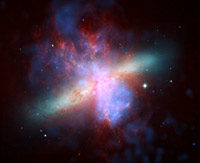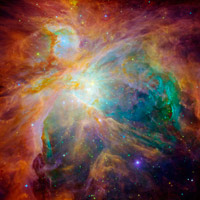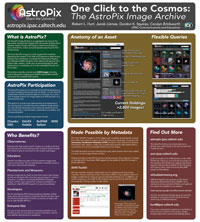Steering Committee / Team
VAMP is a collaborative project between individuals representing Spitzer Science Center, ESA/Hubble, California Academy of Sciences, IPAC/IRSA, and the University of Arizona. Key personnel at major observatories and end-application development organizations have endorsed the project and are committed to seeing success. The three main locations for VAMP development will be IPAC in Pasadena, California, USA, ESA/Hubble in Munich, Germany and California Academy of Sciences (CalAcad), San Francisco, USA.
VAMP is organized into 4 work packages: WP1 Management managed by Robert Hurt, WP2 Metadata managed by Robert Hurt, WP3 Middleware/Core Development managed by Bruce Berriman and WP4 Prototypes managed by Lars Lindberg Christensen.
A Steering Committee oversees the project. The Executive Manager is the WP1 manager Robert Hurt.
The steering committee for the VAMP project became a formal collaboration at the Astro-viz 2006 Workshop in Pasadena in November 2006. Members of this the steering committee are: Lars Lindberg Christensen (ESA/Hubble), Robert Hurt (Spitzer Science Center/IPAC), and Ryan Wyatt (California Academy of Sciences). Prior to November 2006, VAMP lived as the “Virtual Repository” working group of the International Astronomical Union (IAU)’s Communicating Astronomy with VAMP was a Working Group under this commission until 2013 with Adrienne Gauthier (University of Arizona) and Robert Hurt (SSC) as chair.
The Steering Committee members are:
Lars Lindberg Christensen is a science communication specialist heading the Hubble European Space Agency Information Centre group in Munich, Germany. Here, he is responsible for public outreach and education for the NASA/ESA Hubble Space Telescope in Europe.
He obtained his Master’s Degree in physics and astronomy from the University of Copenhagen, Denmark. Before assuming his current position, he spent a decade working as a science communicator and technical specialist for Tycho Brahe Planetarium in Copenhagen.
Lars has more than 100 publications to his credit, most of them in popular science communication and in its theory. His other productive interests lie in the areas of graphical communication, written communication, technical communication and scientific communication. He has written several books, for instance The Hands-On Guide to Science Communicators (Springer, 2006) and Hubble – 15 Years of Discovery (Springer, 2006). His books have been translated to Finnish, Portuguese, Danish, German and Chinese.
He has produced material for a multitude of different media from star shows, laser shows and slide shows, to web, print, TV and radio. His methodology is focused on devising and implementing innovative strategies for the production of efficient science communication and educational material. This work involves working with highly skilled graphics people and technicians, some results of which are visible at: http://www.spacetelescope.org
He is Press Officer for the International Astronomical Union (IAU), a founding member and secretary of the IAU Commission 55 Communicating Astronomy with the Public (http://www.communicatingastronomy.org ), manager of the world-renowned ESA/ESO/NASA Photoshop FITS Liberator project, Outreach & Education Coordinator for the European Virtual Observatory and is the Executive producer and director of the science documentary movie Hubble – 15 Years of Discovery (~800,000 copies distributed). Lars received the Tycho Brahe Medal in 2005 as the youngest recipient so far for his achievements in science communication.
Dr. Robert Hurt is an astronomer currently working on NASA's Spitzer Space Telescope mission, an infrared counterpart to the Hubble Space Telescope. In his role of visualization scientist, Dr. Hurt oversees the various elements of visual communication for public affairs and outreach efforts. These include data renderings, artist’s concepts, and more general topics of visual communication of science. Current interests include developing metadata standards for astronomical imagery and the Virtual Astronomy Multimedia Project. He received his Ph.D in physics from UCLA in 1993 for a study of gas dynamics in starburst galaxies, and other research areas of interest include star formation and active galaxies.
Ryan Wyatt is an astronomer and is the Director of the Morrison Planetarium and Science Visualization at the California Academy of Sciences. Ryan was formerly science visualizer at the American Museum of Natural History.
|

M82, as imaged by Chandra, Hubble and Spitzer telescopes

M42 as imaged by Spitzer and Hubble telescopes

Poster presented at the AAS2013 Conference in Long Beach, CA
|